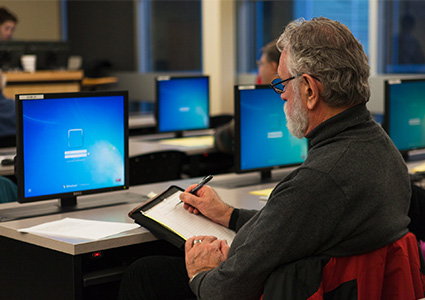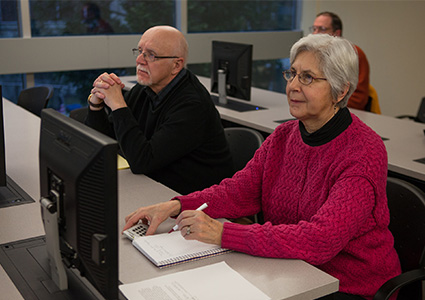The Case for Building a Culture of Nontraditional Students
By Karen Rose
Traditional students are defined as students between the ages of 18-24, and much of my own academic work has been at universities that prioritized creating a comfortable campus culture for these students.
Over the years, I have taken great pride in being part of a team that prepared young adults for a challenging, competitive and an ever-changing work/life landscape. More recently, I have been able to expand my reach by serving as the Age-Friendly University champion and by teaching older adults in the Stockton Institute for Lifelong Learning (SILL), both initiatives of the Stockton Center on Successful Aging (SCOSA).

Prompted by a newsletter from my alma mater that described a program for nontraditional students, I began to reflect on this group of learners with whom I have had little experience. In this article, I will discuss how nontraditional is often defined, why an age-diverse campus that includes traditional and nontraditional students at the undergraduate level is both timely and important and the Douglass Bunting Program (Rutgers University) that began in 1958 and continues to evolve and has elements worth emulating at Stockton.
Defining "Nontradtional"
Although the definition of a nontraditional student has been debated, age (especially being over the age of 24) has been the defining characteristic for this group. According to the National Center for Educational Statistics (NCES: non-traditional definition), age acts as a proxy variable that describes a heterogeneous population of adult students that often have family and work responsibilities, and additional risk factors that can interfere with successful completion of a program (NCES Statistics).
Online undergraduate programs have been a response to hurdles facing nontraditional students, but graduation rates are low (U.S. News and World Report - Online Program Graduation Rates). On the other hand, there are arguments that cultivating a place for nontraditional students may be well worth the effort as they bring life experiences, motivation and problem solving skills that differ from traditional student learners (Potential Positive Attributes of Nontraditional Learners).
The Value of On-Campus Age Diversity
In its Strategic Plan 2025: Choosing Our Path, Stockton University included an enrollment management goal (Goal 4.1) to improve access and opportunity for nontraditional students, a goal that anticipates demographic shifts in the United States. The U.S. population is projected to increase by over 71 million from 2020 to 2060, representing an increase of 25%. Individuals >65 will account for the largest proportion (53%) and individuals <24 the smallest proportion (12%) of this growth. Adults 25-44 and 45-64 will account for 16% and 19% of the increase; thus, the nontraditional group represents a growing market (2017 Census Tables).
Improving access and opportunity for nontraditional students also supports Age-Friendly University efforts in building an age-diverse campus and DEI efforts in building a diverse and respectful community. Finally, it supports additional opportunities for intergenerational student learning preparing students for the workforce environment.
I would argue building a culture of nontraditional students is timely, supports a commitment to a diverse community, has potential to shape the learning experiences of both traditional and nontraditional learners, and reflects the learning environment for most students after graduation."
The Bunting Program at Douglass College (Rutgers University)
The November Newsletter that prompted my reflection described the Bunting Program at Douglass College (Douglass Newsletter - Nontraditional Students Week ). It was established by Douglass dean Mary Bunting in 1958 and designed to recognize the needs of women who wanted to complete college, either part-time or full-time later in their lives and careers. Bunting went on to become president of Radcliffe University and later led to the full involvement of women students at Harvard University. From the start, the Bunting Program acknowledged the demands and time constraints of adult learners and includes:
- Dedicated Space (e.g., lounge area for study in the student center; private lactation space; the Sophia House (that includes a 12-month housing community),
- Unique Advising (mentoring, career planning and personal support that focuses on adult lifestyles and needs; priority early registration for students with children to offset school-family conflicts),
- Social Activities (Sophia Club),
- Financial support specifically for nontraditional students, and
- Two Student Liaisons who work alongside Douglass staff to bring awareness to the specific needs of nontraditional aged students to the larger university community.

As a traditional student at Douglass, I was accustomed to having women of different ages in the classroom because of the Bunting Program, and I had not reflected on how that experience helped to shape my view of learning today. To be truthful, I could not understand the challenges of going to school, working and caring for a family at that time in my life—but I could respect the characteristics of Bunting program participants with whom I worked: they were hard-working, committed to school, and goal-oriented despite life challenges.
As we worked in study groups, I noted that a priority was to learn the material and not to worry about the grade they ‘needed.’ They taught me that if you work hard to understand the material, good grades typically followed—a mantra that I pass on to my current students regularly. In the classroom, I admired their courage to challenge and to ask questions, despite what might now be considered as microaggressions by other students.
Admittedly, this is a generalization, but it does describe the five classmates that I remember to this day. I never thought about how they influenced my own teaching style, but in each class that I teach I begin by telling students two things: challenge me as it helps us all to grow and ask questions because chances are that others have the same question. Sounds quite a bit like my Bunting Program classmates, and I think Mary Bunting would be happy to hear that her initiative has had an impact on the experiences of nontraditional and traditional students at Douglass College.
I would argue building a culture of nontraditional students is timely, supports a commitment to a diverse community, has potential to shape the learning experiences of both traditional and nontraditional learners, and reflects the learning environment for most students after graduation.
Karen Rose is an adjunct faculty member and works for the Stockton Center on Successful Aging.


